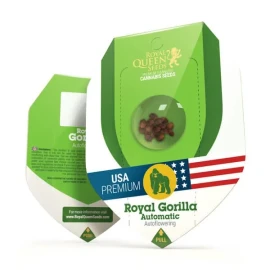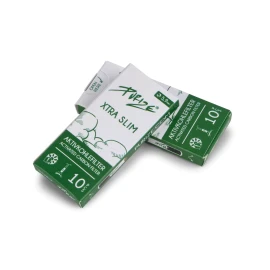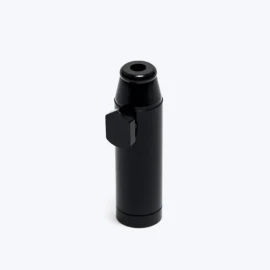Royal Gorilla Automatic
10,00 €
Quick-Glance Stats
| Genetics | 50% Indica / 30% Sativa / 20% Ruderalis |
| THC Content | Up to 20% |
| CBD Content | Minimal/trace amounts |
| Indoor Height | 60–120 cm |
| Outdoor Height | Up to 140 cm |
| Indoor Yield | Up to 400 g/m² |
| Outdoor Yield | 120–170 g/plant |
| Harvest Time | 8–10 weeks from seed |
Introduction
Royal Gorilla Automatic represents a breakthrough in autoflower breeding—a resin-rich, high-potency strain engineered for fast, high-yield cultivation cycles. This comprehensive guide covers everything from optimal growing conditions and feeding schedules to harvest timing and post-processing techniques, ensuring you maximize both yield and quality from this exceptional autoflower.
What is Royal Gorilla Automatic?
Origin & Genetics
Royal Queen Seeds developed Royal Gorilla Automatic by crossing their renowned Royal Gorilla with Royal Cookies and stabilizing the genetics with carefully selected Ruderalis genetics. This strategic breeding program produced an autoflower that maintains the potency and resin production of its photoperiod parents while offering the convenience and speed of automatic flowering.
Genetic Profile & Phenotype Expectations
The typical genetic ratio of approximately 50% Indica, 30% Sativa, and 20% Ruderalis creates a balanced plant structure with compact growth patterns ideal for indoor cultivation. Phenotype traits consistently include dense, resin-coated buds with distinctly short internodes and robust lateral branching. The heavy resin production coupled with pronounced Diesel and Kush aromatics makes this strain particularly appealing for both direct consumption and concentrate production.
Laboratory Statistics
- THC Levels: Consistently reaching up to 20%, with most phenotypes testing between 16-20%
- CBD Content: Minimal levels, typically below 1%
- Primary Terpenes: Myrcene, caryophyllene, and limonene dominate the profile
- Resin Production: Exceptionally high trichome density on both buds and surrounding sugar leaves
Optimal Use Cases
Royal Gorilla Automatic serves recreational users seeking a balanced cerebral and physical experience, while its high resin content makes it excellent for rosin pressing, hash production, and other concentrate extraction methods. The compact growth characteristics make it perfect for discreet indoor grows and small-space cultivation setups.
Effects, Taste & Aroma Profile
Effect Characteristics
The 20% THC content delivers a well-balanced experience that begins with an uplifting cerebral effect followed by deep physical relaxation. The onset typically occurs within 5-10 minutes of consumption, with effects lasting 2-3 hours depending on tolerance and consumption method. Users report enhanced focus during the initial phase, transitioning to a relaxed, contemplative state ideal for evening use.
The balanced Indica-Sativa ratio provides potential benefits for stress relief, mild pain management, and appetite stimulation, though individual responses vary significantly. The potency level makes it suitable for experienced users while remaining manageable for intermediate consumers when used in controlled amounts.
Aroma & Flavor Profile
Primary Notes: Dominant Diesel fuel characteristics blend with classic Kush earthiness, creating a pungent, memorable aroma that intensifies during the final flowering weeks.
Secondary Characteristics: Depending on phenotype expression and curing methods, subtle sweet undertones emerge alongside citrus hints and occasional cookie-like notes inherited from the Royal Cookies lineage.
Consumption Experience: The smoke is typically smooth when properly cured, with the Diesel notes most prominent on inhalation and earthy Kush flavors developing on the exhale.
Consumption Recommendations
Royal Gorilla Automatic performs excellently in evening social sessions or focused relaxation periods. The high resin content makes it particularly suitable for rosin pressing and bubble hash production, with fresh-frozen material yielding exceptional live resin products. Consider starting with smaller amounts to gauge individual tolerance, especially for users new to 20% THC strains.
Quick-Glance Grow Facts
- Seed-to-Harvest: 8–10 weeks
- Light Schedule: 18–20 hours daily throughout lifecycle
- Preferred Medium: Fabric pots with organic soil
- Container Size: 15–20L for single plants, 2–4L for SOG
- Indoor Height: 60–120 cm
- Outdoor Height: Up to 140 cm
- Indoor Yield: Up to 400 g/m²
- Outdoor Yield: 120–170 g/plant
- Best Methods: SOG (Sea of Green), minimal training, direct seeding to final containers
Complete Indoor Growing Guide
Pre-Grow Setup Requirements
Container Selection: Choose fabric pots in 15–20L capacity for maximum individual plant yields, or opt for 2–4L containers when implementing SOG techniques. Fabric containers promote superior root health through air pruning and improved drainage.
Growing Medium: High-quality organic soil or soilless mixes containing coco coir and perlite provide optimal results. Ensure the medium offers good drainage while maintaining moisture retention capabilities essential for the compressed autoflower lifecycle.
Lighting Requirements: Full-spectrum LED systems or HPS lights targeting 400–700 µmol/m²/s PPFD during flowering stages. Position lights to maintain 18–20 hour photoperiods throughout the entire lifecycle, as autoflowers don’t require darkness periods for flowering initiation.
Environmental Controls: Install exhaust fans with inline filters, oscillating fans for air circulation, and maintain temperature ranges between 20–26°C with humidity levels of 65% during vegetative growth, reducing to 40–50% during flowering.
Week-by-Week Development Plan
Week 0 (Germination & Seedling Establishment)
Germinate seeds using rapid paper towel methods or direct sowing into final containers. Plant directly into final pots to avoid transplant shock that can severely impact autoflower development. Maintain gentle lighting at 18–20 hours daily, positioning seedlings 20–30 cm from light sources. Keep soil lightly moist with humidity around 65%.
Weeks 1–2 (Early Vegetative Growth)
Expect compact growth patterns with short internodes and thick first true leaves. Begin with minimal feeding—rely on enriched soil nutrients or very weak nutrient solutions at 0.25–0.5 EC. Avoid any high-stress training techniques during this critical establishment period. Monitor for slow starters that may require slightly higher soil temperatures (22–25°C).
Weeks 3–4 (Vegetative Stretch & Pre-Flower Transition)
Rapid vertical growth typically occurs between weeks 3–5 as plants transition toward flowering. Gradually increase light intensity while ramping nutrients to half-strength vegetative levels, focusing on nitrogen early before transitioning to bloom formulations. SOG growers should finalize canopy arrangements during this period.
Weeks 5–7 (Active Flowering & Bud Development)
Switch to bloom-specific nutrient mixes emphasizing phosphorus and potassium while reducing nitrogen levels. Maintain the 18–20 hour light schedule as buds form rapidly. Monitor environmental conditions closely, keeping humidity between 40–50% and temperatures stable at 20–26°C. Consider bloom boosters and PK supplements, but use conservatively to avoid nutrient burn.
Weeks 7–9 (Ripening & Final Development)
Monitor trichome development closely using magnification—target mostly cloudy trichomes with 10–20% amber for balanced effects. Begin flushing 7–14 days before anticipated harvest using pH-balanced water or very low EC solutions. Prepare drying and curing spaces during this final period.
SOG Implementation Strategy
SOG (Sea of Green) techniques maximize Royal Gorilla Automatic’s compact growth characteristics. Use 2–4L containers with 10–20 plants per square meter, avoiding topping or training. This method produces uniform canopy heights while maximizing total yield per square meter. Control final heights through container size selection and light distance management rather than plant training.
Feeding Protocol
- Seedling Stage (Weeks 1–2): Water only or very weak nutrients at 0.25–0.5 EC
- Vegetative Stage (Weeks 2–4): Balanced NPK at 0.6–0.8 EC
- Flowering Stage (Weeks 4–8): High phosphorus and potassium at 0.9–1.2 EC, reduced nitrogen
- Final Flush (Last 1–2 weeks): pH-balanced water or low EC solution
For organic approaches, use compost teas and bat guano during vegetative growth, transitioning to bone meal and kelp meal during flowering while reducing nitrogen sources in late flower.
Complete Outdoor Growing Guide
Climate Requirements & Timing
Royal Gorilla Automatic thrives in mild to warm climates and can be planted after the last frost date. The 8–10 week lifecycle allows for 2–3 complete cycles per growing season in most temperate regions, making it excellent for continuous harvest strategies.
Container & Site Preparation
Use 15–20L fabric containers for optimal outdoor yields, positioning them in locations receiving 6+ hours of direct sunlight daily. For multiple harvests, implement staggered sowing every 4–6 weeks to ensure continuous production throughout the growing season.
Outdoor Growing Timeline
The 8–10 week seed-to-harvest timeline remains consistent regardless of season length, thanks to the autoflowering genetics. Expect outdoor heights reaching up to 140 cm under optimal conditions, with yields typically ranging from 120–170 grams per plant.
Soil & Nutrition for Outdoor Growing
Prepare amended organic soil incorporating compost, aged manure, and organic amendments. Outdoor plants require more frequent watering, especially during hot weather—implement mulching around root zones to retain moisture and moderate soil temperatures.
Weather Protection & Pest Management
Install protective netting and row covers for early pest prevention. Maintain adequate spacing between plants to promote airflow and reduce mold risk. Use shade cloth during extreme heat periods to prevent stress-induced hermaphroditism.
Multi-Crop Strategy
Implement staggered seed starting every 4–6 weeks for continuous harvests. Consider using smaller containers and SOG techniques outdoors when space is limited, focusing on many small colas rather than single large plants.
Yield Optimization Strategies
Realistic Yield Expectations
Indoor SOG setups can achieve the advertised 400 g/m² under optimal conditions with proper lighting, environment control, and plant management. Outdoor plants typically yield 120–170 grams each, though exceptional conditions can produce higher results.
Maximizing Production
Direct Seeding: Plant seeds directly into final containers to avoid transplant shock that significantly impacts autoflower development.
Container Selection: Use fabric pots in appropriate sizes—15–20L for individual plants, 2–4L for SOG implementations.
Environmental Optimization: Maintain consistent lighting (PPFD targets), excellent airflow, and stable environmental conditions throughout the lifecycle.
Moderate Nutrition: Avoid overfeeding, which can delay development. Organic feeding methods often produce superior terpene profiles.
Stress Avoidance: Minimize plant stress, as autoflowers have limited recovery time due to their compressed lifecycles.
Advanced Optimization Techniques
Progressive Harvesting: Harvest top colas at peak trichome maturity, allowing lower buds additional development time for increased overall quality.
Supplemental Lighting: Carefully implement UV-B or enhanced blue spectrum lighting during late flower to boost resin production while monitoring for heat stress.
Silica Supplementation: Use silica additives to strengthen stem structure and reduce stretch-related damage.
Targeted Bloom Enhancement: Apply PK boosters during specific flowering periods, timing applications to plant development rather than calendar schedules.
Troubleshooting Guide
Common Issues & Solutions
Slow Germination/Weak Seedlings
- Causes: Old seeds, cold soil temperatures, excessive moisture
- Solutions: Warm soil to 22–25°C, ensure proper moisture without waterlogging, test seed viability
Excessive Stretch
- Causes: Insufficient light intensity, excessive heat, improper light distance
- Solutions: Increase light intensity, reduce temperatures, adjust light positioning
Early Yellowing
- Causes: Overwatering, nitrogen deficiency, root problems
- Solutions: Adjust watering schedule, check soil EC levels, assess root health
Nutrient Burn
- Causes: Excessive feeding, incorrect pH, salt buildup
- Solutions: Flush growing medium, reduce nutrient concentration by 20–30%, check pH levels
Late-Flower Bud Rot
- Causes: High humidity, poor airflow, dense canopy
- Solutions: Remove affected areas immediately, increase ventilation, reduce humidity below 45%
Hermaphrodite Development
- Causes: Environmental stress, light leaks, genetic predisposition, excessive heat
- Solutions: Eliminate stress factors, ensure complete darkness during rest periods, maintain stable temperatures
Preventative Measures
Maintain environmental checklists covering temperature ranges, humidity levels, airflow patterns, and feeding schedules. Regular monitoring prevents most issues before they impact plant development or final yields.
Post-Harvest Processing
Drying Protocol
Hang harvested branches or use drying racks in dark environments maintaining 18–21°C with 45–55% relative humidity. Proper drying typically requires 6–10 days until smaller stems snap cleanly rather than bending.
Curing Process
Transfer dried buds to airtight glass jars, maintaining 62–65% relative humidity. Burp jars daily during the first week, gradually reducing frequency as moisture levels stabilize. Minimum curing periods of 2–3 weeks improve smoothness, while 4–8 weeks enhance flavor development and overall quality.
Quality Preservation
Avoid rapid drying that produces harsh smoke, cure in consistently cool environments, and store finished products away from light and heat sources to prevent THC degradation.
Extraction Considerations
Royal Gorilla Automatic’s exceptional resin production makes it excellent for rosin pressing, bubble hash, and solvent-based extractions. Fresh-frozen sugar leaves and small bud material provide superior live resin yields. Consider small-scale extraction techniques using appropriate temperature and pressure protocols.
Strain Comparisons
Royal Gorilla Auto vs Royal Gorilla Photoperiod
The photoperiod version requires light schedule manipulation for flowering initiation and typically produces larger individual plant yields with longer lifecycles. Royal Gorilla Auto offers convenience through automatic flowering and faster turnaround times, making it ideal for multiple crops per season.
Royal Gorilla Auto vs Other Gorilla Genetics
Compared to other Gorilla strains, Royal Gorilla Auto maintains similar potency levels and terpene profiles while offering the speed and simplicity of autoflower genetics. The resin production rivals photoperiod versions, making it excellent for concentrate production.
Royal Gorilla Auto vs Royal Cookies Auto
Royal Gorilla Auto typically produces higher resin levels and more pronounced Diesel aromatics compared to Royal Cookies Auto, while maintaining similar flowering times and cultivation requirements.
Addressing Common Concerns
Autoflower Viability
Autoflowers offer fast harvests, simplified light schedules, and compact growth patterns ideal for small spaces and multiple yearly crops. While individual plant yields may be lower than photoperiods, the speed and convenience often compensate through multiple harvests per season.
Beginner Suitability
Royal Gorilla Automatic suits beginning growers who maintain attention to watering practices and avoid plant stress. The forgiving nature of soil growing and the strain’s resilience make it accessible for newcomers following basic cultivation principles.
Mold Prevention
Dense bud structure requires careful humidity management and adequate airflow during flowering and drying phases. Proper environmental controls and attentive curing practices prevent mold development.
Concentrate Production Potential
The exceptional resin production makes Royal Gorilla Automatic excellent for rosin pressing, hash making, and other concentrate extraction methods. High trichome density on both buds and sugar leaves provides superior extraction yields.
Scientific Data & Terpene Analysis
Laboratory testing consistently shows THC levels reaching up to 20%, with most samples testing between 16-20% depending on growing conditions and phenotype expression. CBD levels remain minimal, typically below 1%.
The dominant terpene profile features myrcene providing relaxing effects, caryophyllene contributing to the spicy undertones and potential anti-inflammatory properties, and limonene adding citrus notes while potentially enhancing mood elevation.
Testing variability occurs between different laboratories and growing conditions, so individual results may vary from reported averages.
Advanced Growing Techniques
Progressive Harvest Method
Harvest top colas when trichomes reach desired maturity, allowing lower buds additional development time. This technique maximizes both quality and total yield while accommodating varying maturation rates throughout the plant.
Container Air Pruning
Fabric containers promote healthy root development through air pruning, preventing root binding and improving nutrient uptake during the compressed autoflower lifecycle.
Minimal Training Approach
SOG setups work best without topping or training—instead, use many small containers to create uniform canopy heights naturally. This approach maximizes plant numbers while minimizing individual plant stress.
Late-Flower Light Optimization
Carefully increase light intensity during final flowering weeks while monitoring for heat stress. Enhanced blue spectrum lighting may boost trichome production when implemented safely.
Beneficial Microorganism Integration
Mycorrhizae and beneficial bacteria can improve nutrient uptake efficiency during the short autoflower lifecycle, potentially increasing both yield and resin production.
Frequently Asked Questions
How long does Royal Gorilla Automatic take to harvest?
8–10 weeks from seed germination to harvest, regardless of season or light schedule.
How tall does Royal Gorilla Auto get?
60–120 cm indoors depending on container size and growing conditions; up to 140 cm outdoors under optimal conditions.
How much THC does Royal Gorilla Auto contain?
Up to 20% THC, with most phenotypes testing between 16-20% depending on growing conditions.
What’s the best way to grow Royal Gorilla Auto?
SOG setups using 2–4L pots for maximum yields, or single plants in 15–20L fabric containers with 18–20 hour daily lighting.
Should I top or train autoflowers?
Minimal training works best—avoid topping and high-stress techniques. Light LST early in development may be beneficial, but many growers achieve best results with no training.
When should I harvest Royal Gorilla Auto?
Monitor trichomes with magnification—harvest when mostly cloudy with 10–20% amber trichomes for balanced effects.
Is flushing necessary for autoflowers?
A 7–14 day flush with pH-balanced water can improve final product smoothness, though organic growing may require minimal flushing.
How do I prevent mold with dense buds?
Maintain humidity below 50% during flowering, ensure adequate airflow, and avoid overcrowding plants. Proper drying and curing practices are essential.
Is Royal Gorilla Automatic good for making concentrates?
Excellent for extractions due to high resin production—suitable for rosin pressing, bubble hash, and other concentrate methods.
Can I get multiple outdoor harvests per year?
Yes—the 8–10 week lifecycle allows 2–3 complete cycles in most temperate climates when started after last frost.
Why plant directly in final containers?
Autoflowers have limited time to recover from transplant shock. Direct seeding prevents stress that can significantly impact final yields.
What feeding problems should I watch for?
Overfeeding causes more problems than underfeeding with autoflowers. Watch for leaf tip burning (nutrient excess) and yellowing lower leaves (nitrogen deficiency or overwatering).
This comprehensive guide provides the foundation for successful Royal Gorilla Automatic cultivation, from initial setup through final processing. The strain’s combination of potency, speed, and resin production makes it an exceptional choice for both personal cultivation and small-scale commercial operations seeking reliable, high-quality results.
Related Products
Frequently Asked Questions
Everything You Need to Know














